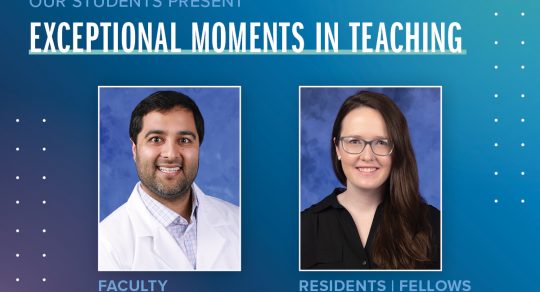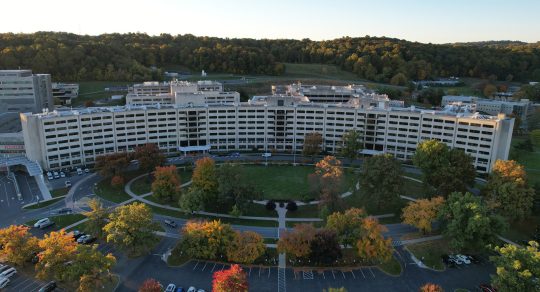Fellowship
Anesthesia/Pain Medicine
The Anesthesia/Pain Medicine Fellowship at Penn State Health Milton S. Hershey Medical Center is a one-year (12-month), ACGME-accredited program that admits four fellows per year.
Explore More
Candidates for the Anesthesia/Pain Medicine Fellowship must be diplomates in good standing of the ABPMR, ABA or ABPN and apply for subspecialty certification through their respective boards. Diplomates of other ABMS member boards may apply for certification in pain medicine through their board if their board becomes a co-sponsor of the Pain Medicine Examination.
Penn State Health’s Pain Medicine Center utilizes a multidisciplinary, comprehensive approach to manage more than 7,000 outpatient visits per year.

Program Overview
Fellows will spend nine four-week blocks in the Pain Medicine Center. This rotation exposes the fellow to a wide variety of chronic pain conditions and is the true core of the fellowship program. The full spectrum of currently accepted interventional pain management procedures are performed under direct supervision of the faculty. Additionally, an interventional pain management course on an injection phantom occurs in the beginning of the academic year that decreases the learning curve for fluoroscopically guided injections. Early on in their training, fellows are involved in evaluation and treatment of chronic pain patients who are referred to the pain center by both primary care physicians as well as specialists from various fields of medicine.
Our patients are offered a variety of interventional pain procedures including spinal cord stimulator trials and implants, minimally invasive lumbar decompression, sacroiliac joint fusion interspinous spacer implants, peripheral nerve stimulation, dorsal root ganglion stimulation, epidural steroid injections, radiofrequency ablation, sacroiliac joint injections, peripheral nerve blocks, and others.
The strong didactic program consists of weekly lectures, monthly journal clubs, case presentations, monthly spine rounds, two annual OSCEs with simulation, interventional sessions with simulation, fluoroscopic case presentations, quarterly multidisciplinary patient comfort conferences and daily patient-related teaching.
Fellow education is centered on three major areas:
Acquiring comprehensive knowledge of diagnosis and treatment of the more chronic pain conditions
Becoming proficient with a wide variety of interventional pain management procedures
Providing an overview of the information required to become a consultant in pain management and preparing for the subspecialty board examination
Fellows are on-home call one week in four, on average. During call, the fellows will be exposed to consultative care of inpatients with chronic pain conditions. In addition, they will work with regional anesthesia teams.
Learn More about the Fellowship
The program accepts applications only through ERAS.
Leadership


Fellowship Program Coordinator, Anesthesiology and Perioperative Medicine
Anesthesia/Pain Medicine Fellowship
Supporting Your Training
Curriculum Details
Depending on the fellow's primary specialty, rotations will take place in the following:
Spine surgery, where the fellow will participate in the evaluation of patients with spine surgeons and gain an understanding of the surgical options available for patients with pain related to spinal pathology
Palliative care, with exposure to end-of-life care
Neuroradiology, which offers a full range of diagnostic and interventional procedures
Physical medicine and rehabilitation in patients with disabilities resulting from musculoskeletal disorders including spine-related disorders, spinal cord injury, arthritis, trauma and limb amputations
Acute pain service, with a high volume of epidural and peripheral nerve catheters placed for perioperative pain control
Psychiatry, where fellows will become familiar with the basics of psychiatric assessment
Anesthesia, where the fellow will gain experience with airway management, peripheral vascular access, intravenous sedation and management of side effects and complications associated with intravenous sedation
Outside rotations to ACGME-accredited institutions are also available.
Two-week block - anesthesia graduates exempt
During this rotation, the fellows are exposed to a variety of regional anesthesia techniques such as thoracic and lumbar epidural catheters, upper and lower extremity plexus catheters, paravertebral catheters and peripheral nerve catheters, as well as experience in ultrasound-guided procedures.
Fellows will learn the administration of neuraxial anesthesia, including placement of a minimum of 15 thoracic or lumbar epidural injections using an interlaminar technique.
They learn the management of patients in acute post-operative period during daily rounds. There is a strong didactic curriculum including lectures, reading material and discussions. The acute pain inpatient experience is supervised in the assessment and management of inpatients with acute pain. The fellow must document involvement with a minimum of 50 new patients.
The Clinical Competence Committee Evaluation form is used for assessment. The rotation director in charge of the fellow during the elective reports to the fellowship director.
Two-week block - anesthesia graduates exempt
The fellow will learn how to obtain intravenous access in a minimum of 15 patients and basic airway management, including mask ventilation in 15 patients and endotracheal intubation in 15 patients.
The Clinical Competence Committee Evaluation form is used for assessment. The rotation director in charge of the fellow during the elective reports to the fellowship director.
Two-week block
This rotation provides the fellow with an understanding of the surgical options available for patients with pain related to spinal pathology. Fellows also learn a varied perspective on the assessment, diagnosis, and treatment of patients with the most common presenting symptoms to all pain management centers. This rotation could also involve pump implantation exposure with neurosurgery. This rotation may be done with either neurosurgery or orthopedics.
The Clinical Competence Committee Evaluation form is used for assessment. The rotation director in charge of the fellow during the elective reports to the fellowship director.
Two-week block – psychiatry graduates exempt
This rotation provides the fellow with the ability to carry out a complete psychiatric history with special attention to psychiatric and pain comorbidities. The fellow must conduct a complete mental status examination on a minimum of 15 patients, and must demonstrate this ability in five patients to a faculty observer.
The program will provide educational experience in frequent psychiatric and pain co-morbidities, which include substance-related, mood, anxiety, somatoform, factitious and personality disorders. The program will also provide educational experience in the effects of pain medications on mental status. The fellow must understand the principles and techniques of the psychosocial therapies, with special attention to supportive and cognitive behavioral therapies, sufficient to explain to a patient and make a referral when indicated.
The fellow will spend time at Rehab Options, a multi-disciplinary pain rehabilitation program.
The Clinical Competence Committee Evaluation form is used for assessment. The rotation director in charge of the fellow during the elective reports to the fellowship director.
Two-week block - physical medicine and rehabilitation graduates exempt
This rotation provides the fellow with ability to perform a comprehensive musculoskeletal and appropriate neuromuscular history and examination with emphasis on both structure and function as it applies to diagnosing acute and chronic pain problems and developing rehabilitation programs. This will include assessments of static and dynamic flexibility, strength, coordination and agility for peripheral joint, spinal and soft-tissue pain conditions.
Fellows will gain an understanding of the natural history of various musculoskeletal pain disorders and be able to appropriately integrate therapeutic modalities and surgical intervention in the treatment algorithm as well as have an understanding of the indicators and interpretation of electro-diagnostic studies.
Fellows must gain significant hands-on experience in the musculoskeletal and neuromuscular assessment of 15 patients, and demonstrate proficiency in the clinical evaluation and rehabilitation plan development of a minimum of five patients.
The Clinical Competence Committee Evaluation form is used for assessment. The rotation director in charge of the fellow during the elective reports to the fellowship director.
Two-week block
This rotation provides the fellow with a supervised longitudinal experience in an ambulatory and inpatient population that requires palliative care. The experience will include understanding a clinical approach to the multi-dimensional treatments that comprise palliative care, and an understanding of strategies to integrate pain management into this multi-dimensional treatment model.
The fellow must document longitudinal involvement with a minimum of 10 patients who require palliative care.
The Clinical Competence Committee Evaluation form is used for assessment. The rotation director in charge of the fellow during the elective reports to the fellowship director.
Two-week block
This rotation provides the fellow with an understanding of the imaging studies such as MRI, CT scans and X-rays for the diagnosis of spine related disorders. In addition, there may be exposure to discography and kyphoplasty or vertebroplasty.
The Clinical Competence Committee Evaluation form is used for assessment. The rotation director in charge of the fellow during the elective reports to the fellowship director.
OSCE
The Objective Structured Clinical Exam is an examination to test clinical skill performance and competence in skills such as communication in clinical skills during an H-and-P examination as well as during an interventional procedure. Two OSCEs will be conducted within the year.
There will be two stations set up. The first station will be a new patient H-and-P exam with a standardized patient present. The fellow will be given an initial pain assessment form, which has already been filled out by a nurse. One of the faculty will evaluate the fellow's performance.
The other station will be a procedure. The fellow will talk to one of the faculty as the "patient" as far as introduction and consent, and then talk to the phantom as the "patient" when the procedure starts. One of the faculty will be the voice of the phantom. One of the other faculty will run the fluoro machine, and there will be a nurse present. The fellow will be given the procedure setup form to read prior to entry into the procedure room.
All faculty involved will evaluate the fellows, and results of the OSCE are discussed at the fellow's next evaluation with the program director.
CRM
Crisis Resource Management training is a three-hour interactive program to provide teams with the skills needed to identify common communication and teamwork problems and, through simulation scenarios, correct or avoid issues. The session includes introduction to the environment and the simulation, two scenarios with a video debrief of performance after each scenario, lecture on the principles of CRM and an evaluation of the program.
Upon completion, the participants should be able to verbalize key concepts of CRM for optimal performance in a crisis, recognize common errors in self and others in a crisis situation, and articulate the application of CRM principles to the work environment and daily life activities.
Fellow Honors and Recognitions
Penn State College of Medicine and Penn State Health Milton S. Hershey Medical Center accept ongoing nominations for the Exceptional Moments in Teaching award. The award, given monthly by the Office for a Respectful Learning Environment, accepts nominations from College of Medicine students who are invited to submit narratives about faculty members, residents, fellows, nurses or any other educators who challenge them and provide an exceptional learning experience. See more about the award here.
Previous nominees from the Anesthesia/Pain Medicine Fellowship are listed here.



